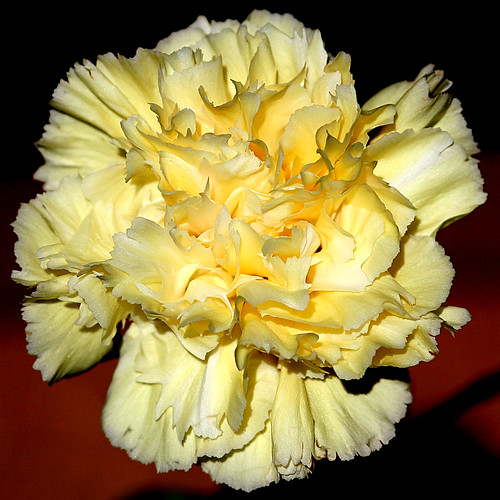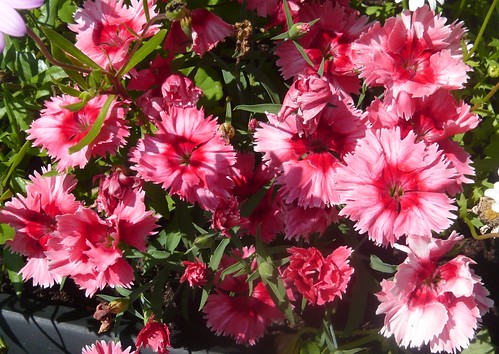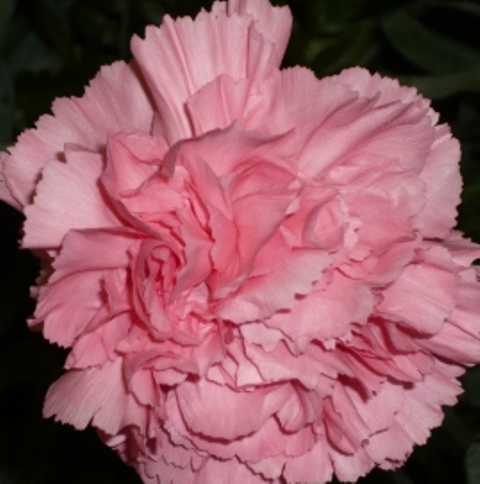Growing Pinks for Cottage Gardens

Pinks are ‘divine flowers’ that can be planted in late April / May or October and produce a continuous supply of flowers suitable for cutting or exhibiting. They are perennials that are at their best for 2-3 summers. Scent, colour and uniformity are just 3 reasons for growing Pinks or other varieties of Dianthus.
Cultivation of Pinks
Pinks are completely trouble free if planted in a sunny position, in free draining soil. (asking for trouble there)
Occasionally water like any other garden plant and dead head after flowering.
Pinks bloom from early spring until the first frosts.
Hardy Pinks don’t mind the cold, so no need to lift them over the cold winter months.
Pinks will be a talking point in winter due to their silver/grey leaves .
Each spring tidy up around the plants and work in a fertilizer like Growmore, dried blood or Superphosphate
Tips and Ideas for Good Pinks.
Try growing Pinks in containers or growbags which can be placed in a sheltered sunny spot in your garden. It saves weeding and makes feeding and watering easier.
Grow a range of varieties with long stems and good colour. Pinks flower all summer but have 3-4 flushes of flower so with a mix of varieties there should always be some available for cutting.
Take softwood cuttings in spring or allow plants to self seed.
The perennial double flowering Carnation, Dianthus Caryophyllus needs more care to get button hole quality flowers but there are 100’s of Dianthus species to grow.
No need to mulch or disbud Pinks
Varieties Recommended by The British National Carnation and Pinks Society.
‘Freckles, a Camellia Rose, flecked and spotted scarlet. Double blooms and highly scented. One of the C.H. Fielder’s Imperial Pinks. This Pink is one of the very best to grow. Supplied from Hayward’s Carnations and Pinks on telephone 01243 576700
Widecombe Fair, raised in 1974 a Pinkish/Cream with a hint of Yellow. Double blooms and scented. A flower favoured by florists to use in bridal bouquets as it blends so well with other pastel blooms. A real discussion point. Supplied by Allwoods on telephone 01273 844229
Devon Wizard, raised in, Devon in 1987 a Reddish/Purple bloom on stout stems. Double blooms and clove scented. Another winner from the Whetman stable and a real eye catcher. Supplied by Whetman’s on telephone 01626 863328
Sam Barlow, raised in the 19th century, a White ground with zoned Purple Double blooms. A very pretty flower that has truly stood the test of time. Supplied by Southview Nurseries on telephone 0118 9732206
Laced Hero, raised in 1947, White ground, laced Purple, zoned black. Double blooms. One of the best laced varieties around. Supplied by Kingstone Cottage Nursery on telephone 01989 565267’
Photo credit flickr pizzodisevo
 credit ndrwfgg
credit ndrwfgg
Pinks are perfectly hardy growing their best in a neutral to alkaline well drained garden soil. Once planted they can remain in their planted position for several years hence there popularity in a cottage garden. The colour range is enormous, ranging from deep red right the way through the shades of pink, orange, and on to white. Not forgetting all the bi-colours and laced varieties. Pinks will provide a waft of that heady clove cinnamon scent every time you pass it.
Cultivation Tips
All Pinks prefer an open sunny situation so avoid planting too close to other plants where air movement might be restricted.
Feed and water at the base not over the leaves. Pinks do not like to be too wet.
Pinks will grow and flower their best if fed regularly during the growing season with a rose or tomato 4:4:8 fertiliser. This is particularly important after the first flush of blooms has finished in order to encourage them to flower again. Start them off with some blood fish and bone when planting.
Deadhead when the main stem has finished flowering pick or cut off the stem at the base of the plant in order to keep the plant tidy and to encourage repeat flowering.
Hardy Pinks don’t mind the cold. The silver grey leaves last through winter and bring you the promise that spring growth is just around the corner.
Varieties Worth Growing
Doris with its light pink ground and a zoned red eye.
Mrs Sinkins a clear white self colour, A word of warning on this variety. It only flowers once per season and then only for a month or so, but still worth growing for its outstanding perfume.
Or Grans Favourite with its white background with pink lacing,
Cranmere Pool AGM is one I am growing at the moment with a clean white outer and a dark maroon centre.
I have just bought cuttings of Haytor Rock and Laced Monarch and was advised to grow then on quite dry.
The Alpine varieties that look so good include Whatfield Can-Can, Mendelsham Minx and Waithmans Beauty
Varieties and Colours to Grow
- Doris pink with a red inner
- Gran’s Favourite white with rings of purple.
- Devon Cream yellow. (many good Pinks come from Devon)
- Devon Dove white
- Carmine Letticia Wyatt
- Arctic Fire a dwarf pink 6″ tall for rockeries.
Propagate from cuttings selecting healthy non-flowering shoots in July/August and insert in a pot of seed compost. Water in well, cover with a polythene bag or mist regularly for the first couple of weeks. Place on a windowsill out of direct sunshine and wait for approximately four weeks, checking from time to time that they have not dried out. When rooted, pot on into 3inch pots.
- Pinks at T&M



3 thoughts on “Growing Pinks for Cottage Gardens”
Comments are closed.